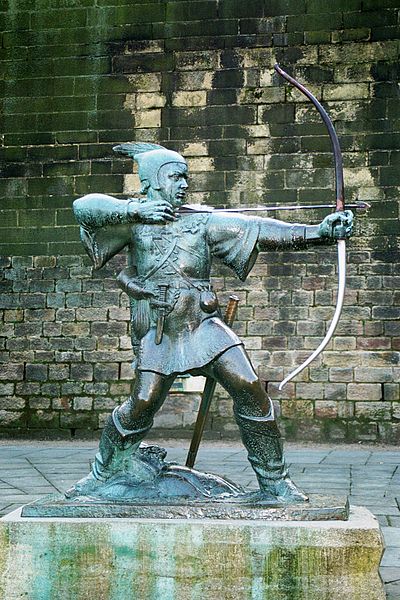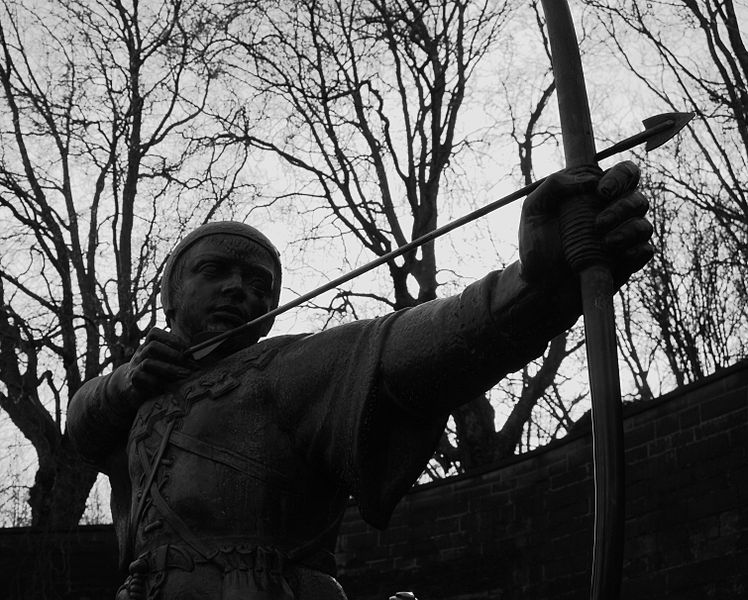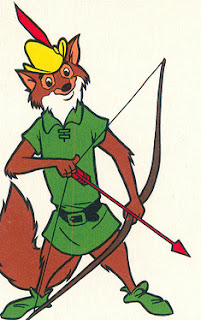At some point, everyone gets exposed to the heroic tale of Robin Hood. Everyone's heard at least one version of it, or seen one of the many movie adaptations. The story of the bandit who robs from the rich and gives to the poor is so old, and it's been re-told so much, no one really know just where it comes from...or whether or not it's true. But a great many brave souls have written books, and turned them into films, in order to depict this hero.
Only a few have done it well.
The Story
The oldest recorded mention of Robin Hood can be found in a 15th century poem. It references "Robyn hode in scherewode stod," which becomes Robin Hood of Sherwood Forest. A 16th century reference places Robin in Loxley near South Yorkshire, an area that's been associated with Robin dating as far back as 1422. Records do indicate that a man named Robin Hood lived around Wakefield, Yorkshire, in the 13th and 14th centuries.
Piers Plowman created the first "rhymes of Robin Hood" known to exist, from the late 14th century, but these have not survived. Others referenced them in the 15th and 16th centuries, long enough for history to be blurry. In the earliest versions of the story Robin is known for being an excellent archer and a sworn enemy to the Sheriff of Nottingham. Little John, the Miller's son and Will Scarlet all appear in early versions of the legend.
Over the centuries, Robin Hood's legend grew. Even Shakespeare referenced Robin Hood in his works. The first printed version of the tale is A Gest of Robyn Hode, circa 1475. It's more a collection of short stories than a full-length novel, each one playing out like an episode.
The earliest plays about Robin were written in the late 1500s. The first novel about the hero was created in 1883, when Howard Pyle wrote The Merry Adventures of Robin Hood. It's this version that solidifies Robin's reputation as a philanthropist who takes from the wealthy to give to the less fortunate. This novel also made him a contemporary of King Richard (the Lionheart).
It's an image he still has today.
In The Merry Adventures of Robin Hood, the reader follows Robin's path to becoming a famous outlaw. He gets into a conflict in the forest and begins recruiting merry men while evading the authorities. Robin and Little John battle with staffs, he meets Friar Tuck and he continuously battles the Sheriff of Nottingham. At the end of the novel, Robin and his men receive a royal pardon from the returning King Richard (who's been away at the Crusade).
It was Pyle's first novel, and a deviation from the original ballads. In the earliest versions of the story, Robin isn't the good guy -- he's just a thief and a bad-tempered one at that. The book was a huge hit, and it cemented Robin's more heroic image for all the succeeding generations.
The story is so well-known, the legend so entertaining, it very naturally lends itself to adaptation. By the time the novel appeared, Robin Hood had already appeared in poetry and plays...so why not in film, too?
The Film(s)
The very first film adaptation of the story happened way, way back in 1908. A silent English short film, Robin Hood and his Merry Men features Robin as a former earl and a pretty Maid Marian who loves him anyway. America made their own version, titled simply Robin Hood, in 1912. This 30-minute version includes characters like Friar Tuck and the villainous sheriff, in addition to Robin and Marian. Not to be outdone, the Brits made another silent film in 1912, this time called Robin Hood Outlawed.
Lots more movies followed. Three more were made in 1913. One was Ivanhoe, one of the more popular versions of the story. But Robin Hood wouldn't gain real movie fame until 1922, when he was Douglas Fairbanks. Fairbanks was one of the biggest silent film stars of all time, and this version is still considered to be a classic. It had the biggest sets Hollywood had ever built, up to that point, and incredible action scenes involving swordfighting, Castle-climbing and all sorts of other thrilling moments.
But talkies were invented, and the story had to be adapted again...and again and again and again. More feature-length Robin Hood films followed in 1946, 1948, 1950 and 1951. Three Robin Hood movies were made in 1952 alone, one a live-action joint by Disney, who would go on to make a much more definitive version of the story later. It was turned into film again in 1954, 1959, 1960, 1962 and a 1964 version moves Robin to 1930s Chicago and stars Frank Sinatra as "Robbo" (I'm not kidding).
Someone has made a Robin Hood film pretty much every single year since. Some are unwatchable, some are good...only a handful are worth mentioning.
The 1973 version of Robin Hood, made by Disney, is undoubtedly one of the best ever. It was actually a low-budget production for the megastudio. The 21st animated feature the studio produced, this version of the story turned Robin and all his pals into animals who act a great deal like us. Alan-a-Dale appears as a rooster who narrates the tale, and Robin's heroic reputation is fully intact. In the end, Robin gets his royal pardon and goes off to marry the lovely Maid Marian.
But it wasn't until 1991 that someone created the film version of the story. A box office monster and star-studded action fest, Robin Hood:Prince of Thieves starred Kevin Costner as the title character and I personally hate it. I'll never forgive Costner for not at least attempting an English accent of any kind. And Christian Slater? It's an insult to moviegoers. Still, this is considered one of the best versions of the story and it's one of the few to feature Will Scarlet (the aforementioned Slater), though he's been Robin's companion since the 1400s.
This time, Robin isn't just a nobleman but a Crusader. He joined King Richard, who was famously separated from his men and captured before he could get home. This time, Robin is given a Saracen buddy that he's brought with him from Crusade and he has to deal with a witch instead of just a crooked sheriff. In this version, Will Scarlet is Robin's half-brother (oddly). But the ending does remain intact: King Richard shows up to pardon Robin just as he's marrying his lady love, Maid Marian.
An ambitious version of the story was created with Russell Crowe in the lead in 2010. This time, Robin Longstride (Crowe) is an archer in King Richard's army and a veteran of the Third Crusade. He returns home with friends Little John, Allan A'Dayle and Will Scarlett, but runs into all sorts of problems. When he makes a promise to Robert Loxley to return a sword, things start to get all mixed up.
Robin assumes Loxley's identity and returns to a homeland in turmoil, as King John has now assumed the throne. This film doesn't end with a pardon for Robin. In a deviation from the original novel, King John labels him as an outlaw for life instead.
Which One's the Best?
And they're all good films, I'm sure, but if you want to see the very best adaptation of Robin Hood that ever was made, you'll get the one from 1938. It's the only one with Errol Flynn, and that makes it the only one worth watching.
The Adventures of Robin Hood is the clear winner when it comes to film adaptations (sorry, Disney). This swashbuckling epic was filmed in stunning Technicolor. Errol's real-life love interest Olivia de Havilland (perhaps better-known to moviegoers as Melanie Hamilton from Gone With the Wind) played Marian and the incomparable Claude Rains rounds out the cast.
Richard the Lionheart has been taken captive by the Austrians (historically accurate) and Prince John has assumed power. Taxes have been raised, and the people are discontent. All of this reflects the real history. Only Robin, Earl of Locksley, opposes him. The archer even boldly goes right to the castle to insult John to his face, then eludes all of his men in an impressive bit of heroics. It's enough to impress the watching Maid Marian, anyway.
Robin flees to Sherwood Forest with friend Will Scarlet. Together they meet Little John, who spars with Robin. Soon enough Robin meets Friar Tuck and the band of Merry Men is complete.
It's a heck of a good movie, and Flynn is the definitive Robin Hood. He became indelibly associated with the role, and he and his Maid Marian would go on to star in 4 more movies together. The flick won three Oscars, and was nominated for Best Picture. It pays decent enough homage to the 19th-century novel and captures much of the flavor of the original Robin Hood legend, and it's one version you absolutely shouldn't miss.















0 comments:
Post a Comment